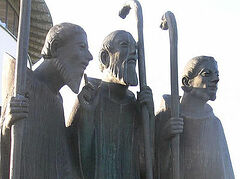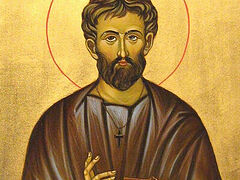Part 2: Missionaries and Enlighteners
Part 3: Great Monastic Saints and Penitents
Part 4: Holy Women—Martyrs, Abbesses, Nuns and Queens
We continue with an amazing series on the Orthodox saints of what is now call Benelux, by Matthew Hartley.
St. Guy of Anderlecht (†1012)
 St. Guy of Anderlecht depicted as a pilgrim in a Book of Hours, c. 1484-1529. Photo: Wikipedia Many of the saints covered in this essay were of noble, even royal, birth. St. Guy (Guido) of Anderlecht was not one of them. He was born into poverty and toiled at an agricultural existence. He worked faithfully at menial jobs as a sacristan in his local church, at Laken near Brussels. He also labored whenever able at tending and nursing the sick.
St. Guy of Anderlecht depicted as a pilgrim in a Book of Hours, c. 1484-1529. Photo: Wikipedia Many of the saints covered in this essay were of noble, even royal, birth. St. Guy (Guido) of Anderlecht was not one of them. He was born into poverty and toiled at an agricultural existence. He worked faithfully at menial jobs as a sacristan in his local church, at Laken near Brussels. He also labored whenever able at tending and nursing the sick.
Despite his own poverty, he freely gave away all of his earnings to the poor. Wishing to enlarge his earnings so as to have more money to give to the poor, he was persuaded by a merchant once to go in with him on a business venture; however, when the ship carrying their wares sank, St. Guy took this as a divine admonition and never again let himself get entangled in any worldly matter. In his extreme generosity, in which he gave away all his substance despite his own utter poverty, he rather resembles the righteous Dobri Dobrev (†2018) of Bulgaria, a holy man of very recent times who undertook a similar lifelong podvig.
St. Guy undertook a long, penitential pilgrimage to Rome and Jerusalem, spending some seven years venerating the holy sites. Once, after returning to Anderlecht, he fell ill from a pestilence that had befallen him while selflessly tending to sick pilgrims he had been guiding. Thus St. Guy, “the Poor Man of Anderlecht,” gave up his holy soul to the Lord in the year 1012.
St. Guy demonstrates that sanctity is possible to the poorest of the poor, as well as to the laity, just as some of the other saints featured here show how royals and monastics have found the way to the Heavenly homeland. His life proves that all are called and can attain sainthood regardless of their social station and life circumstances.
Part 7: A Modern Day Wonderworker
St. John Maximovitch, Archbishop of Brussels (†1966)
 St. John Maximovitch, Archbishop of Brussels and Western Europe (in red), celebrating liturgy according to the Western Rite
St. John Maximovitch, Archbishop of Brussels and Western Europe (in red), celebrating liturgy according to the Western Rite
One of the best known and most beloved saints of the 20th century is St. John Maximovitch of Shanghai and San Francisco. This great ascetic and wonderworking archbishop, whose life and activities spanned much of the globe, is one of the greatest lights of the Church in our times.
While a recap of his entire life and career may not be necessary here, in the context of any discussion of the Orthodox history of the Low Countries mention of his efforts in that region of Europe must be made. Through him, the Low Countries were graced with an Orthodox saint in the mid-20th century, some 900 years after the West’s fall into schism.
St. John’s involvement with this area was lengthy, meaningful, and spiritually productive. From 1951 to 1962, he served as Archbishop of Western Europe. His see was at first located in Paris, but was subsequently moved to Brussels. Western Europe at that time, including the Low Countries, had a sizable Russian diaspora who had fled the persecution and turmoil following the Revolution. St. John thus lent his presence directly to these lands, giving them a saint of modern times they can call their own.
As archbishop St. John impressed all with his immense holiness, miracles, and seemingly superhuman asceticism. Significantly for our discussion, he probably did more than anyone else in the past century to revive the veneration of the pre-Schism Western saints. He would insist that the priests in Europe under him learn about the Orthodox saints of their area, find where their relics were preserved, and conduct services for them, especially on their feast days. He personally tirelessly researched their lives and collected abundant information about them, much of which might otherwise have been lost. An essay like this present one could scarcely have been written had it not been for his efforts decades ago. St. John also did much to revive Western pre-Schism liturgical forms, and the current Western Rite in Orthodoxy owes much to him. Today a church in Antwerp is dedicated to him.
After spending his last years as Archbishop of San Francisco in the United States, St. John reposed in 1966 in Seattle while in prayer before the Kursk Root icon of the Mother of God. Russia, Serbia, China, the Philippines, Western Europe (including the Low Countries), and America all can claim him among their saints. He is a truly universal figure.
Part 8. Present Situation and Conclusion
The Orthodox presence in the Low Countries today is small, comprising about two percent of the religious composition of Luxembourg, about one percent in Belgium, and a similarly low percentage in the Netherlands. Much of the region was a Protestant stronghold for centuries, though the trend of late seems to be increasingly irreligious and secular.
Greek and Russian immigrants accounted for the bulk of Orthodox faithful in these lands over the past two or three centuries. For instance, the return of Orthodoxy to Belgian soil only began in the late nineteenth century with the opening of a chapel in the Russian embassy in Brussels. In 1900 an Orthodox church was established in Antwerp to serve Greek sailors. The twentieth century saw a sizable increase in the Orthodox presence in the region due to the large numbers of displaced Russians fleeing the aftermath of the Revolution. Still, the statistics reflect an urgent need for an Orthodox re-evangelization of a region long since fallen into heterodoxy and outright unbelief. According to one source, as of at least 2006 there were only about 80,000 Orthodox believers in Belgium and a mere 1,000 or so in Luxembourg. Clearly, the field is ripe.
Centuries ago, the saints of this region labored mightily to bring its people out of pagan darkness and to establish and confirm them in the Faith of Christ. Many of the greatest holy people to ever grace Western Europe labored in the Low Countries, rescuing the ancestors of today’s residents from the very darkness which seems once more to have enveloped the land. But the seed of revival is present. With an Orthodox presence, albeit small, once more established in these countries, the Church can once again grow there and bring the people back into Her embrace. Through the prayers of the region’s many amazing saints, may we live to see this blessed hope become a reality. Those saints contended against even greater dangers and difficulties than those that confront us today, and they reaped a glorious harvest of souls for Christ.
Holy Orthodox saints of the Low Countries, pray to God for us!




